To prevent subsequent claims, always ask if anything is unclear. It is more cost-effective to obtain precise instructions from a superior or to make a telephone call to the customer than to lose one's reputation or to have to answer a claim for damages. In most cases, it is sufficient to use two arrows pointing upward to indicate that goods are to be transported a particular way up.
Stacking means loading, packing or stowing packages in layers so that the edges of the packages lie flush above each other.
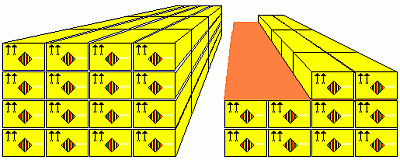 |
|
| Corrugated board cartons stacked with and without a hardboard anchor |
Pressure-sensitive cartons with homogeneous dimensions must always be stacked carefully ensuring that the sides and end faces lie flush. This ensures that only the load-carrying vertical sections are subjected to loads. When using cartons made of corrugated board, it is essential to check where possible that the flutes of the boards are vertical. If it could be disadvantageous that individual packages are not firmly connected to each other, anchors made of materials with a large surface area, such as hardboard, paperboard, plastic sheeting etc., are to be introduced during stowage.
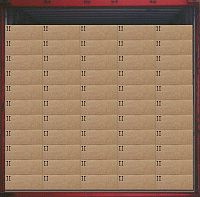 |
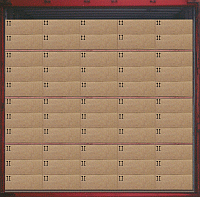 |
|
| Stacked cartons, with and without plywood anchors | ||
Wall boards and ceiling boards, plastic profiles and similar loads generally have single or double belt battens as "built-in packaging". To prevent any harmful loads from being applied to the boards themselves, the belt battens must be stacked flush on top of each other, and not for instance staggered to save on stowage space. Load securing material must also be attached to these points.
 |
|
| Ceiling boards - loaded correctly, packed one above the other |
 |
|
| Ceiling boards - loaded in a staggered pattern and thus incorrectly |
For particular loads, stacked stowage is an essential requirement, e.g. for pressure-sensitive cartons. In this case, any loads which arise must always be directed onto the load-bearing parts of a package. Even the smallest deviation from the vertical position can cause damage to the cargo.
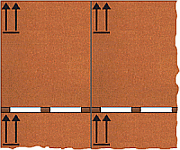 |
 |
||
| Correct: Packed edge to edge | Incorrect: Untidy packing |
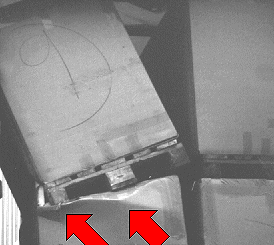 |
|
| Damage caused by incorrect stacking |
The risk of packing errors can be avoided by using adequate interlayer dunnage.
Indonesian tobacco bales also demand correct "stacking". The only intermediate layers which are permitted are: plastic sheeting, kraft paper and other similar materials which can be used to "anchor" the layers to each other. Despite not being bound tightly, the stack as a whole is comparatively stable.
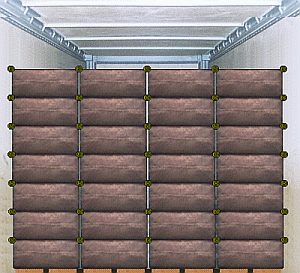 |
|
| Possibility of ventilating Indonesian tobacco bales with rolled up mats. Floor dunnage made of wooden dunnage boards. |
If gaps need to be left for reasons of ventilation or small gaps are required for stowage considerations, they can be achieved by using rolled up mats or equivalent materials.
 |
|
| Narrow lattices and laths to ensure air circulation |
If only narrow lattices, laths, boards or other strip-shaped materials can be used to ensure adequate air circulation, it must be ensured that they are placed on parts of the load which have sufficient load-bearing capacity.
With cardboard cartons, the load-bearing points are vertically below the side walls:
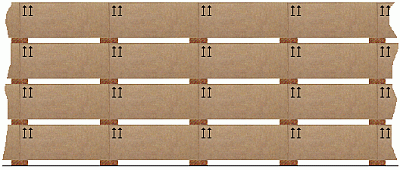 |
|
| Correct: The wooden supports are placed on the load-bearing parts of the cartons, i.e. the sides |
 |
|
| Incorrect: The wooden supports are placed on non-load- bearing parts |
Tightly filled paper bags or sacks should be stacked in the same way. If the bags do not completely fill a hold or do not form a complete transverse tier, a sufficiently stable stack or interconnection of bags or layers can be achieved by inserting wooden dunnage or paper anchors or similar materials.
In most cases, it is sufficient to just insert the anchors in the top layers and/or on the sides; Generally, segregation material, dunnage and load securing material should be used sparingly, both for reasons of expense and to prevent stowage loss.
If dunnage has to be laid because "wet cargo" has to be packed together with dry cargo in a container, the dunnage must be laid without large gaps, otherwise, tightly filled paper bags and similar loads could burst or tear and could "bleed".
 |
|
| Sufficient floor dunnage prevents the bags from "bursting". |
 |
|
| Insufficient floor dunnage makes it easy for the bags to "burst" |
High load levels are produced when stowing cargoes in layers with intermediate layers made of squared lumber or wooden dunnage, since only linear bearing surfaces are produced in the area of the bottom and intermediate layers. Only cargoes insensitive to load forces may be stowed in this way. Harmful pressure can be reduced to an acceptable level by using relatively soft wood or by using intermediate layers made of rubber.
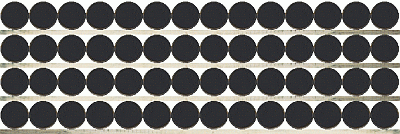 |
|
| Stacking cargo with a sufficient loading capacity in layers |
The pressure-sensitivity of fiber cement pipes or the susceptibility of ceramic pipes to breakage must be taken into consideration when selecting the type of dunnage:
 |
|||
| Side view | View from the top | Front view | |
| Stowage of socket pipes in layers and in alternate orientation | |||
 |
|||
| Side view | View from the top | Front view | |
| Stowage of socket pipes in layers and in alternate orientation |
|||
All strong and resilient goods of various shapes or sizes can be packed in a
cross-tie stow. Remaining gaps must be filled. Wooden dunnage and similar intermediate layers should also be used as anchors. The need to bridge or pad out stowage gaps can result from a difference in the dimensions of cargo items.
In principle, this involves the cargo items interlocking with each other. It can generally be used to minimize the effort required for securing cargo. Methods like this improve the stability of the cargo. But, as we have said: This method may only be used with resilient goods.
A complete transverse cross-tie refers to stowage in which goods fill the stowage space from side wall to side wall. Anchors do not need to be inserted if equivalent measures are taken. This stowage method is suitable for all means of transport having load-bearing side walls or with low lateral stresses, e.g. in rail transport. If the walls of a cargo container are not sufficiently strong, the cargo items must be stowed as a cross-tie, interconnected with anchors or secured using other special measures. It should always be considered that the speed of unloading can be increased by selecting the right anchor materials. The use of mechanical aids should be encouraged and not hindered in any way. Some examples of a complete transverse cross-tie have already been provided under the other stowage methods. The following warning must be taken seriously: "Complete transverse cross-tie stowage is only safe if the sides of the loading space can withstand the load forces!"
 |
Special care is required when loading curtainsiders, trucks with tarpaulins and roof bows, open-sided containers etc. Vertical lateral tiers can be secured well on the "open" side, e.g. in the direction of a container door, by staggering the layers backward as the tier increases in height. The lateral tiers are then no longer vertical but at a slight angle to the vertical. A gradient of around 10° is recommended. At a stowage height of 2.5 m, the top layer is offset from the bottom layer by about 0.40 m.
Diagonal stowage can be practicable under certain circumstances, from the point of view of loading and unloading, on flatracks, trailers, container bolsters, trucks, certain types of freight car and similar vehicles, so that a number of teams can work at the same time. With this method, cargo of the same type or goods destined for the same recipient are loaded diagonally, to enable the cargo items to be accessed as quickly as possible. In contrast to conventional ship cargo, all goods must be destined for a single place of unloading. Onward transport with remaining diagonal load blocks is not possible.
The term bilge and cantline refers to a loading method in which packages are stowed or fitted into indentations produced by the round or rounded shape of other packages.
Genuine bilge and cantline stowage "on the quarter" is produced when stowing wooden barrels. This stowage method is only used very rarely nowadays.
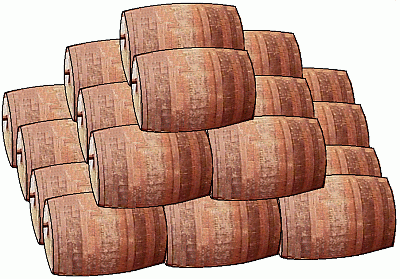 |
|
| Wooden barrels stowed with the bilge and cantline method |
There are some modified methods for stowing drum and barrel loads in containers, which are to be found in the section dealing with the loading and securing of drum loads. The term "bilge and cantline" is usually also used to mean "bilge and cantline on the quarter", although this is not strictly correct.
 |
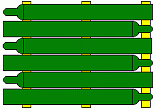 |
||
| Gas cylinders stowed with the bilge and cantline method | Even better: Stowed bilge and cantline and with alternate orientation |
The figure on the left is a good example of how thin rubber nets are used to increase friction. The alternate orientation method makes it easier to load the cylinders with other goods and reduces the overall risk of damage.
Continued in Section 4.2.4.3